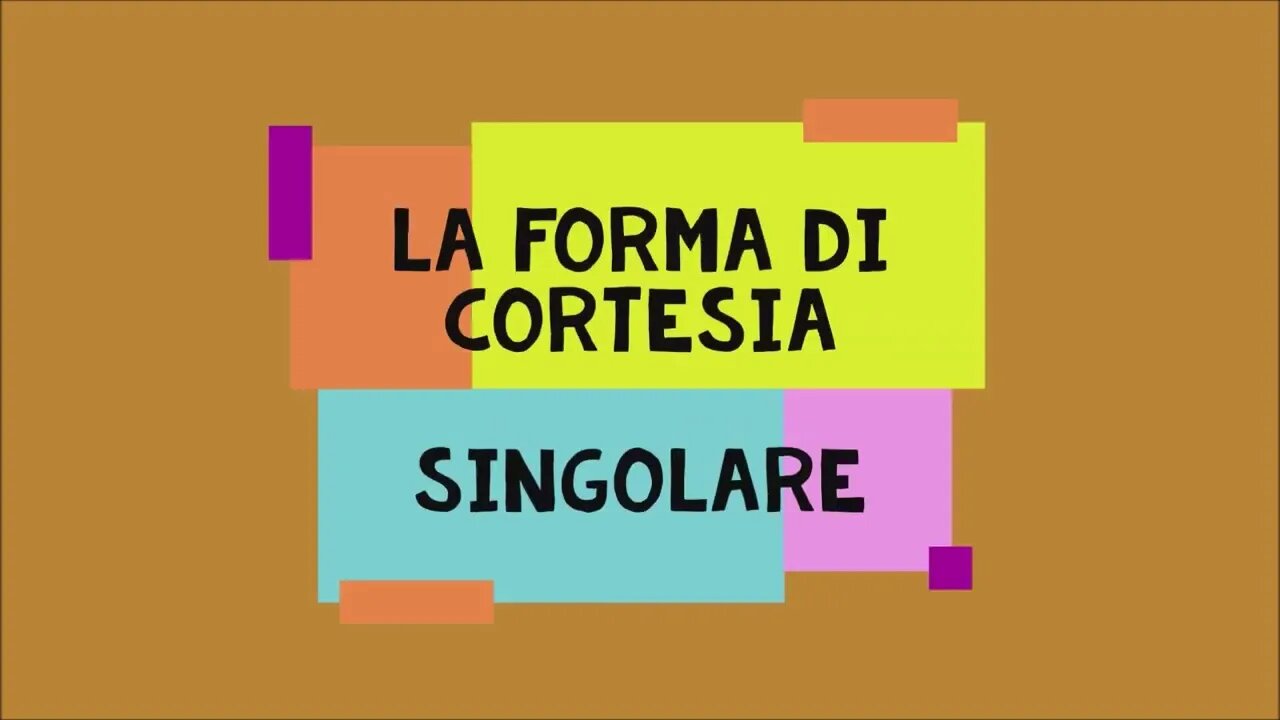Premium Only Content

"Unlock the Secrets of Italian Politeness: Using Direct and Indirect Pronouns Like a Native Speaker"
#RobertoBorzellinoLinguaitalianaperstranieri.
La forma di cortesia in italiano è spesso usata per mostrare rispetto verso gli altri ed è un aspetto importante della lingua e della cultura italiana. In questo video ci concentreremo sull'uso della forma educata con i pronomi diretti e indiretti.
Iniziamo con i pronomi diretti. I pronomi diretti sostituiscono l'oggetto della frase e si collocano prima del verbo. Quando si usa la forma educata, si usa il pronome di terza persona singolare "Le" invece di "Ti". Ad esempio:
"Posso aiutarti?" diventa "Posso aiutarla?". (Posso aiutarti? - forma educata)
Passiamo ora ai pronomi indiretti. I pronomi indiretti sostituiscono l'oggetto indiretto della frase e si collocano prima del verbo. Quando si usa la forma educata, si usa il pronome di terza persona singolare "Le" invece di "Ti". Ad esempio:
"Ti ho mandato una mail" diventa "Le ho mandato una mail" (forma educata).
È importante notare che quando si usano i pronomi indiretti, si cambia anche la preposizione usata. Invece di "a te", si usa "a Lei". Ad esempio:
"Ti ho telefonato" diventa "Le ho telefonato" (forma educata).
In sintesi, quando si usa la forma educata con i pronomi diretti e indiretti, si usa il pronome di terza persona singolare "Le" invece di "Ti" e si cambia la preposizione usata con i pronomi indiretti da "a te" a "a Lei".
Speriamo che questa spiegazione vi abbia aiutato a capire l'uso della forma educata con i pronomi diretti e indiretti in italiano. Grazie per averci seguito!
Se vi è piaciuto questo prompt, mettete un "mi piace" sulla pagina di ricerca dei prompt, in modo che possa continuare a migliorarlo. E non dimenticate di iscrivervi al nostro canale per altre lezioni di italiano!
The polite form in Italian is often used to show respect towards others, and it's an important aspect of Italian language and culture. In this video, we'll focus on the use of the polite form with direct and indirect pronouns.
First, let's start with direct pronouns. Direct pronouns replace the object of the sentence and are placed before the verb. When using the polite form, you would use the third person singular pronoun "Le" instead of "Ti." For example:
"Posso aiutarti?" (Can I help you?) becomes "Posso aiutarla?" (Can I help you? - polite form)
Now, let's move on to indirect pronouns. Indirect pronouns replace the indirect object of the sentence and are placed before the verb. When using the polite form, you would use the third person singular pronoun "Le" instead of "Ti." For example:
"Ti ho mandato una mail" (I sent you an email) becomes "Le ho mandato una mail" (I sent you an email - polite form)
It's important to note that when using indirect pronouns, you would also change the preposition used. Instead of "a te," you would use "a Lei." For example:
"Ti ho telefonato" (I called you) becomes "Le ho telefonato" (I called you - polite form)
In summary, when using the polite form with direct and indirect pronouns, you would use the third person singular pronoun "Le" instead of "Ti" and change the preposition used with indirect pronouns from "a te" to "a Lei."
We hope this explanation helped you understand the use of polite form with direct and indirect pronouns in Italian. Thank you for watching!
If you enjoyed this prompt, please like it on the prompt search page so we know to keep enhancing it. And don't forget to subscribe to our channel for more Italian language lessons!
The videos in this channel are dedicated to the Italian language and culture. The main topics will be grammar lessons, exercises, dialogues from everyday life, history, geography, fashion, cooking and much more.
My books on Amazon. Level A1/A2 I recommend the following textbooks:
For students of Russian language: https://www.amazon.it/dp/1521583730
For English language students: https://www.amazon.it/dp/1657435474
For students of German language: https://www.amazon.it/dp/B095GJ5WS5
For Chinese language students: https://www.amazon.it/dp/B08YQQWT32
For students of the Brazilian language: https://www.amazon.it/dp/B0B5KVJNJ9
For students at B1/B2/C1/C2 level, I recommend my novels: dictionary, exercises and solutions.
https://www.amazon.it/dp/B08DSVJZNB (Dead End Road)
https://www.amazon.it/dp/B08DSSCRLZ (The Red Jasper)
https://www.amazon.it/dp/B08TW5FLVK (The Curse of the Isle of Cora)
https://www.amazon.it/dp/B095GRWSBR (Militaria)
-
 12:24
12:24
The Shannon Joy Show
13 hours ago🔥From Flock Cameras to Palantir: America’s Expanding Digital Cage🔥
6222 -
 LIVE
LIVE
BEK TV
22 hours agoTrent Loos in the Morning - 8/27/2025
336 watching -
 LIVE
LIVE
The Bubba Army
21 hours agoTaylor Swift & Travis Kelce ENGAGED! - Bubba the Love Sponge® Show | 8/27/25
3,034 watching -
 40:14
40:14
Uncommon Sense In Current Times
16 hours ago $1.23 earnedThe Dating Crisis in America | J.P. De Gance on the Church’s Role in Restoring Family & Faith
25.4K3 -
 12:35
12:35
Red Pill MMA
18 hours agoNow We Know The Truth.. Hero Who Stopped Raja Jackson Speaks Out
2.84K4 -
 41:04
41:04
Coin Stories with Natalie Brunell
1 day agoCooking, Culture & Crypto: Norma Chu’s Food Empire Turns Bitcoin Treasury
5.75K -
 8:03
8:03
MattMorseTV
17 hours ago $7.28 earnedThings in the UK just got INSANE...
84.2K127 -
 3:02:10
3:02:10
daniellesmithab
11 hours agoAlberta Next: Fort McMurray Town Hall
15K1 -
 2:11:17
2:11:17
Side Scrollers Podcast
20 hours agoINSANE Illegal Migrant Propaganda Xbox Game + Paypal REFUSES To Pay Dev + More | Side Scrollers
62.7K3 -
 20:58
20:58
GritsGG
1 day agoProtect the President Challenge on Warzone!
18.7K